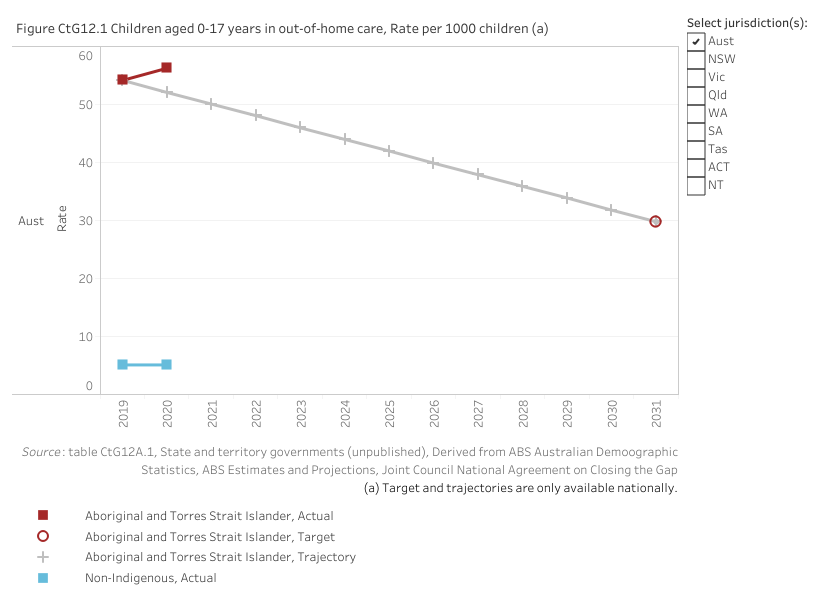TARGET 12
By 2031, reduce the rate of overrepresentation of Aboriginal and Torres Strait Islander children (0-17 years old) in out-of-home care by 45 per cent
Dashboard snapshot: The data below are the most recent at the time of preparing the July 2021 report. Please go to the dashboard to access the current data.
Nationally in 2020, the rate of Aboriginal and Torres Strait Islander children aged 0–17 years in out-of-home care was 56.3 per 1000 children in the population (figure CtG12.1).
This in an increase from 54.2 per 1000 children in 2019 (the baseline year).
Nationally, based on the most recent year of data, this target is not on track to be met.

The assessment below reflects progress from the baseline year to the current year (ie improvement or otherwise in the rate). This differs to the national assessment against the trajectory (above), which compares the current year rate to the rate on the target trajectory at the same time period.
Target data specifications
Outcome: | Aboriginal and Torres Strait Islander children are not overrepresented in the child protection system. |
|---|---|
Target: | By 2031, reduce the rate of overrepresentation of Aboriginal and Torres Strait Islander children (0-17 years old) in out-of-home care by 45 per cent. |
Indicator: | The rate of Aboriginal and Torres Strait Islander children aged 0-17 years in out-of-home care. |
Measure: | This measure is defined as: Numerator — number of Aboriginal and Torres Strait Islander children aged 0-17 years in out-of-home care, at 30 June Denominator — number of Aboriginal and Torres Strait Islander children aged 0-17 years in the population, at 30 June and is presented as a rate per 1000 children. |
Target established: | National Agreement on Closing the Gap July 2020 |
Latest dashboard update: | 23 June 2021 |
Indicator type: | Target |
Interpretation of change: | A low or decreasing rate is desirable. A decrease from the baseline year is an improvement. |
Data source(s): | Name (numerator): Child Protection National Minimum Data Set (CP NMDS), State and territory governments (for the most recent year) Frequency: Annual Name (denominator): Estimates and Projections for Aboriginal and Torres Strait Islander population Frequency: Annual (data revised on a five-yearly basis) Documentation (links): https://www.aihw.gov.au/reports-data/health-welfare-services/child-protection/overview |
Data provider: | Provider name (numerator): Australian Institute of Health and Welfare Provider area: Child protection Provider name (numerator — most recent year only): State and territory governments Provider name (denominator): Australian Bureau of Statistics Provider area: Demography |
Baseline year: | 2019 |
Target year: | 2031 |
Disaggregations: | State and territory and Australia, by Indigenous status |
Computation: | Numerator divided by Denominator multiplied by 1000 Counting rules Includes (numerator):
Excludes (numerator):
Denominator:
Supporting calculations
|
Data quality considerations: | 2018-19 was the first year that a single nationally consistent definition of out-of-home care has been applied across all states and territories. Prior to this, reporting of out-of-home care was not nationally consistent, and therefore historical data are not provided for this target. Data by Indigenous status are influenced by the quality of Aboriginal and Torres Strait Islander identification of young people in the CP NMDS (not stated categories are reported separately in the data table). |
Future reporting: | Additional disaggregations required for future reporting:
|
Supporting indicators
Driver
- Number of Aboriginal and Torres Strait Islander children in out-of-home care
- Proportion of children in out-of-home care (0-17 years old) that are Aboriginal and Torres Strait Islander
- Proportion of children on care and protection order that are Aboriginal and Torres Strait Islander
Contextual information
- Proportion of children (0-17 years old) who spent time in out-of-home care by length of time categories that are Aboriginal and Torres Strait Islander
e.g. 12 months, 24 months etc. - Measuring progress of the application of the Aboriginal and Torres Strait Islander Child Placement Principle (ATSICPP): Proportion of Aboriginal and Torres Strait Islander children in out-of-home care
By type of placement; by relationship with caregiver - Proportion of children aged 0-17 in out-of-home care that are Aboriginal and Torres Strait Islander who were placed with relatives or kin, or other Aboriginal and Torres Strait Islander carers
- Proportion of children aged 0-17 in out-of-home care that are Aboriginal and Torres Strait Islander who have current documented and approved cultural support plans
- Proportion of children admitted to out-of-home care that are Aboriginal and Torres Strait Islander
- Proportion of children who exited out-of-home-care to a permanency outcome that are Aboriginal and Torres Strait Islander
- Proportion of children 0-17 discharged from out-of-home care that are Aboriginal and Torres Strait Islander
- Proportion of children that are Aboriginal and Torres Strait Islander aged 0-16 who exited out-of-home care to reunification in the previous year and did not return to out-of-home care in 12 months or less
- Proportion of children who were subjects of substantiations of notifications that are Aboriginal and Torres Strait Islander
- Rates of substantiation of a notification by type of abuse
Including emotional abuse, neglect, physical abuse and sexual abuse - Proportion of children who were the subject of a substantiation of a notification that are Aboriginal and Torres Strait Islander by type of abuse
Including emotional abuse, neglect, physical abuse and sexual abuse
